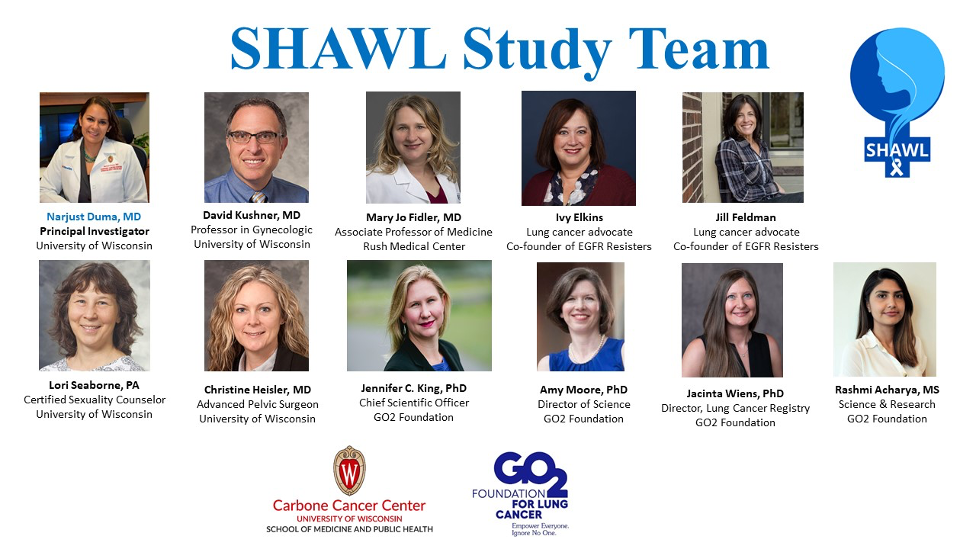Article
SHAWL Study: A Sexual Health Assessment in Women With Lung Cancer
Author(s):
Data suggest that up to 95% of patients with lung cancer score below the fiftieth percentile on sexual function during and after completion of cancer-directed therapy.
Narjust Duma, MD

Data suggest that up to 95% of patients with lung cancer score below the fiftieth percentile on sexual function during and after completion of cancer-directed therapy, with most issues related to sexual dysfunction persisting rather than improving over time.1 Data from previous studies have indicated that the impact of these therapies on sexual function is distressing to most patients with lung cancer, and sexual concerns are related to both higher symptom distress and worse functional status.2,3 Biological, psychological, and interpersonal factors all contribute to sexual dysfunction, and investigators have estimated that this dysfunction affects 40% to 100% of patients with lung cancer.4
The subject of sexual dysfunction is not often addressed during routine oncology visits. A 2018 ASCO guideline on this topic states, “There remains an overall reluctance from both clinicians and patients to talk about cancer- and treatment-related sexual difficulties.”5,6 Several barriers are hindering the discussion of sexuality for patients with lung cancer, including a lack of adequate training for clinicians, the assumption that sexuality is only about intercourse, the speculation that older patients are not interested in having an active sex life, the misconception that treatments are not available, and an overall low comfort level discussing the subject.
Additionally, because of the lack of data surrounding sexual dysfunction in patients with lung cancer, it can be challenging to focus the discussion on the most common issues and learn about potential interventions to improve the problem. The scarcity of the data and the lack of awareness continue to make sexual dysfunction for women with lung cancer an understudied and underreported issue. Often, patients are timid or do not feel comfortable starting the conversation, so it is our duty as their oncology team to address this. Several tools exist for assessing sexuality, including questionnaires, and there are methods to inform how to broach the subject.7,8
Most of the data on sexual dysfunction in patients with lung cancer precede the approval of the treatments that we are now using for the disease. As such, there is a need not only to understand how various cancer treatments affect aspects of sexuality in our patients with lung cancer, but also to move toward practical assessments that will help us develop targeted interventions to address sexual dysfunction in these patients.
To this end, in collaboration with the GO2 Foundation for Lung Cancer and the University of Wisconsin Carbone Cancer Center, we are launching the SHAWL Study (Sexual Health Assessment in Women with Lung Cancer), an international study designed to understand the effects of lung cancer treatments in women with lung cancer (Figure 1,2). The SHAWL study is the largest study to date to explore sexual dysfunction in this patient population. Results from the study are anticipated in early 2021. This research is expected to change the way we understand sexual health in female patients with lung cancer.

Who can participate in the SHAWL study?
All women with lung cancer, independently of cancer stage, treatment type, and geographic location are eligible to participate in the SHAWL study. The survey takes between 5 to 15 minutes and is confidential. The survey is available at the GO2 Foundation Lung Cancer Registry. If you are already part of the registry, the survey can be found in your surveys tab. If you are new to the registry, you will need to create a profile, enter basic information about your lung cancer, and the survey will become available in your surveys tab. For more information on the SHAWL study, visit: https://bit.ly/2OikpQh.

References
- Shell JA, Carolan M, Zhang Y, Meneses KD. The longitudinal effects of cancer treatment on sexuality in individuals with lung cancer. Oncol Nurs Forum. 2008;35(1):73-79. doi:10.1188/08.ONF.73-79
- Sarna L, Brown JK, Cooley ME, et al. Quality of life and meaning of illness of women with lung cancer. Oncol Nurs Forum. 2005;32(1):E9-E19. doi:10.1188/05.ONF.E9-E19
- Sarna L. Correlates of symptom distress in women with lung cancer. Cancer Pract. 1993;1(1):21-28.
- Furlow B. Sexual dysfunction in patients with lung disease. The Lancet Respir Med. 2014;2(6):439. doi:10.1016/s2213-2600(14)70081-5
- Carter J, Lacchetti C, Andersen BL, et al. Interventions to address sexual problems in people with cancer: American Society of Clinical Oncology clinical practice guideline adaptation of Cancer Care Ontario guideline. J Clin Oncol. 2018;36(5):492-511. doi:10.1200/JCO.2017.75.8995
- Bober SL, Varela VS. Sexuality in adult cancer survivors: challenges and intervention. J Clin Oncol. 2012;30(30):3712-3719. doi:10.1200/JCO.2012.41.7915
- Annon JS. The PLISSIT model: A proposed conceptual scheme for the behavioral treatment of sexual problems. J Sex Educ Ther. 1976;2(1):1-15. doi:10.1080/01614576.1976.11074483
- Mick J, Hughes M, Cohen MZ. Using the BETTER model to assess sexuality. Clin J Oncol Nurs. 2004;8(1):84-86. doi:10.1188/04.CJON.84-86









